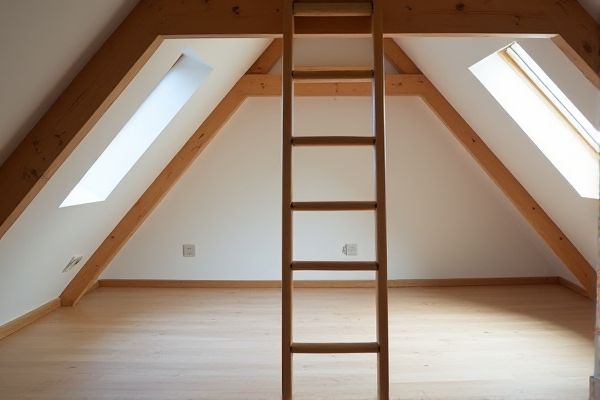
Choosing between a loft ladder and an attic ladder depends on your available space and ease of access preferences, with loft ladders typically designed for smaller openings and attic ladders often featuring foldable mechanisms for compact storage. Discover more about which option best suits Your home's needs by reading the full article.
Table of Comparison
| Feature | Loft Ladder | Attic Ladder |
|---|---|---|
| Installation Location | Inside loft access opening | Inside attic entrance, often ceiling-mounted |
| Design | Fixed or folding steps, manually operated | Foldable or telescoping, space-saving design |
| Material | Wood, aluminum, or steel | Aluminum or wood mostly |
| Space Efficiency | Less compact, may take more floor space | Highly compact, folds into ceiling recess |
| Weight Capacity | Typically 200-250 lbs (90-113 kg) | Typically 250-300 lbs (113-136 kg) |
| Usage | Temporary or occasional access | Frequent, convenient access |
| Price Range | Lower to mid-range ($50-$150) | Mid to higher range ($150-$400) |
| Safety Features | Basic grips, steps may be narrow | Anti-slip steps, handrails, sturdy build |
| Maintenance | Simple, occasional tightening | Requires regular inspection for folds/joints |
Introduction: Loft Ladder vs Attic Ladder
A loft ladder and an attic ladder both provide access to upper storage or living spaces, but they differ primarily in design and installation. Loft ladders are often fixed or foldable units suited for smaller openings, while attic ladders typically retract or fold into the ceiling, saving space when not in use. Choosing the right ladder depends on your ceiling height, available space, and frequency of access to your loft or attic.
Defining Loft Ladders and Attic Ladders
Loft ladders and attic ladders both provide access to upper storage spaces but differ primarily in design and installation. Loft ladders typically feature a fixed structure designed for frequent use in living spaces, while attic ladders are often retractable or foldable, suited for occasional access to less-finished areas. Understanding these distinctions helps you choose the right ladder based on your space, usage frequency, and installation needs.
Key Differences Between Loft Ladders and Attic Ladders
Loft ladders are typically designed for quick access to storage spaces within the ceiling cavity, often featuring lightweight, foldable designs that fit into a loft hatch. Attic ladders generally provide more robust construction, allowing access to attic spaces used for storage or living areas, and usually include telescoping or slide-out mechanisms for ease of use. Key differences lie in their installation requirements, load capacity, and intended usage, with loft ladders favoring compact, occasional access and attic ladders supporting more frequent, heavier use.
Material Options: Wood, Aluminum, and Steel
Loft ladders and attic ladders come in various material options including wood, aluminum, and steel, each offering unique benefits tailored to your needs. Wooden ladders provide a classic aesthetic and sturdy feel, ideal for traditional interiors, while aluminum ladders deliver lightweight durability and corrosion resistance, making them easy to handle and maintain. Steel ladders offer maximum strength and longevity, perfect for frequently used access points requiring enhanced stability.
Space and Installation Requirements
Loft ladders typically require more storage space inside the room when retracted, as they often fold into multiple sections, whereas attic ladders tend to be more compact with a single, telescoping design. Installation for loft ladders usually demands a larger opening and more ceiling reinforcement due to their heavier, foldable structure, while attic ladders can be installed with a smaller hatch and lighter support frame. Choosing between the two depends on the available ceiling height, floor space, and the ease of access needed for regular use.
Safety Features and Load Capacity
Loft ladders typically feature non-slip treads and sturdy handrails designed for residential use, supporting load capacities ranging from 150 to 250 pounds. Attic ladders often boast enhanced safety features such as reinforced locking mechanisms, wider steps, and higher weight limits, accommodating loads up to 350 pounds or more for commercial and heavy-duty residential applications. Choosing between the two depends on the required load-bearing capacity and the specific safety requirements of the access point.
Ease of Use and Accessibility
Loft ladders typically feature a straightforward design with fixed steps, offering stable and easy access to loft spaces, making them ideal for frequent use. Attic ladders often fold or retract, saving space but potentially requiring more effort to deploy, which can affect convenience and accessibility. Your choice depends on how often you need to access the space and the balance between ease of use and storage efficiency.
Insulation and Energy Efficiency
Loft ladders often lack built-in insulation, which can lead to heat loss through the attic opening, reducing overall energy efficiency in a home. Attic ladders typically feature insulated covers or seals designed to minimize air leaks and maintain better thermal performance. Choosing an attic ladder with a high R-value insulated hatch helps improve insulation, lowering energy costs and enhancing indoor comfort.
Cost Comparison and Budget Considerations
Loft ladders generally cost less than attic ladders due to simpler designs and materials, making them a budget-friendly choice for accessing storage spaces. Attic ladders often feature more robust construction and additional safety features, which increase the price but provide greater durability and ease of use. When planning your project, consider both initial costs and long-term value to ensure your budget covers installation and maintenance without compromising safety.
Choosing the Right Ladder for Your Space
Choosing the right ladder for your space depends on ceiling height, available room, and frequency of use. Loft ladders are ideal for smaller openings and tight spaces, providing compact access without sacrificing stability, while attic ladders often accommodate larger openings and heavier loads, better suited for regular use or moving bulky items. Measure your ceiling height and floor space carefully to ensure the ladder fits comfortably and meets your structural needs.
 homyna.com
homyna.com